
(This sculpture is introduced with 7 photographs: one from every side and one in semi-frontal perspective.) The sculpture represents two human heads joined by the nape. It is completely worked from every side, and do not show traces of the original pebble or fragment of rock. The engraving that separates the two heads is carved like every other part of the sculpture. See the drawing (Fig.2) for a easier interpretation.
The analysis of this sculpture is divided in 22 points:
- typology of representation
- finding place
- chronology
- typology of the perspective
- physical anthropology
- typology of technology
- intentional portrait
- composition and shape
- typology of the style
- artistic activity
- hair and beard
- religion
- bicephaly
- cults
- rituals
- mythes
- magic of hunting
- magic of fecundity
- symbol
- Paleolithic shamanism
- aesthetics
- science of Acheuleans TYPOLOGY OF REPRESENTATION
It is a bicephalic anthropomorphic lithic sculpture, since it joins two human heads with an only nape. In the evolved Acheulean bicephalic zooanthropomorphic sculptures also exist, in how much they join a human head to one of animal (Figg. 1, 2, 3, 4, 5, 6, 8, 9 ).
FINDING PLACE
I have found this lithic sculpture at Maribo in Denmark, in secondary lying: not a "true" Paleolithic layer, as I did not find any lithic tools in association.
The findings of Paleolithic lithic sculptures found in secondary lying are many. As an example, the Venus of Savignano (Italy) found in 1924, was in an alluvial zone (I made there research in 60's, and there was no trace of lithic tools), and has been attributed from the scholars of Paleolithic art to the Aurignacian, for affinity with other small Paleolithic feminine figurines with same typology.
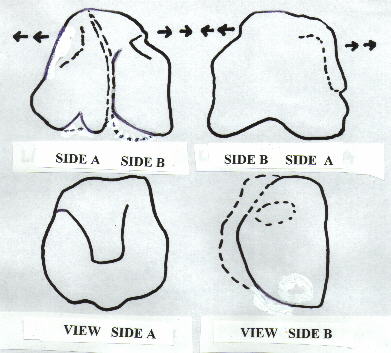
The head (side B) is a SEMI - FRONTAL REPRESENTATION, in how much there is the lateral profile, and half face in frontal view (Face side B). This type of representation is common in the Paleolithic lithic sculpture, where the other half of the face is not represented. A real nose is not represented, but it is deduced from the shape of the profile of the head. The eye and the mouth are constituted from two hollows due to removal of the flint, and are indicative, even if not of good workmanship.
The incision that separates the two heads (two parallel lines dotted from the bottom upwards) has been obtained by percussion, and also to model the two jaws.
CHRONOLOGY
This anthropomorphic sculpture of Maribo, that I have found in 1977, has been never published, in how much I attributed it to the evolved Acheulean, that is to the final phase of the Lower Paleolithic, and at the time, it was said that in Denmark the Lower Paleolihic did not exist, as the earth was covered from the ice, and therefore, for me it was an insoluble problem. Recently in Denmark the Paleolithic has been dated at 100,000 years, that is at the final phase of the Lower Paleolithic, and therefore I decided to publish it .
I am always convinced that this sculpture is datable to the evolued Acheulean.
As is well known, chronology is based on cultural phases, and these are named after the type of tools.
In Italy the evolued Acheulean, or final, has been developed during the Riss ice age and before 350,000 years ago, but the average date in use in Italy is 200.000 years. Always in Italy, the successive cultural phase is the Mousterian, dated from 60,000 to 40,000 years ago. However, I am convinced that the man has lived in Denmark, like in Italy. For Denmark, very cold periods can be excluded; but if the evidence is not found, i.e., if no Lower Paleolithic artifacts produced earlier in the warm period are found, this is probably due to destruction by alluvial rolling produced by sea waves and moving glaciers.
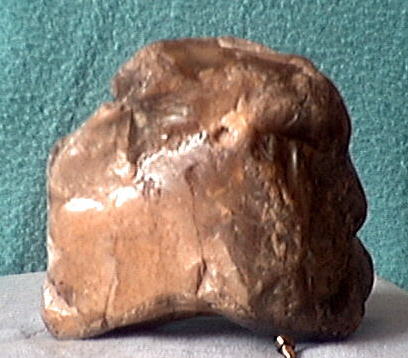
The head (side A)has anatomical characters similar to the pre - sapiens. (Both the pre-neanderthalians and the pre-sapiens are still hypothetical men.)
TYPOLOGY OF THE PERSPECTIVE
The perspective is one of the main components of the History of art who from every era has studied the various and different types of perspective vision.
The Greeks invented in scientific way the "central perspective", applied to the great pictures; in order to see the perspective, it was necessary to watch them staying in front at the center, in how much, if the pictures were seen from the sides, it was no possible to see the perspective.
In this sculpture of Maribo, in order to perceive the images depicted, it is necessary to look at each head in semi-frontal perspective view, otherwise the shape of each head cannot be fully understood.
If the sculpture is twirled in your hands you can see it better, but the perspective is always semi-frontal.
PHYSICAL ANTHROPOLOGY
If it is true that the evolved or final Acheulean is dated from before 350,000 years to 60,000 years ago, its duration was about 300,000 years, and in this very long period no skeletons have been found that would indicate to us who the man or men of the evolved Acheulean were.
The men attributed to this phase from the anthropologists are all hypothetical; that is, in this phase a process of evolution is assumed from the findings of Homo erectus, dated before 450,000 years ago, through hypothetical presapiens and preneanderthalian types, in order to reach the findings of Homo sapiens neanderthalensis and Homo sapiens sapiens with datings of 40,000-30,000 years ago. However, it is a widely held opinion among many anthropologists (but it is still a hypothesis) that the evolved Acheulean man is Homo erectus.
It is hoped that the anthropology makes recourse, in this phase of absence of skeletal findings, also to the representation of human heads of the sculptures of the evolued Acheulean.
The human types represented in these sculptures, generally, have always some features of the head that remember and distinguish Homo erectus from the presapiens and the preneanderthalians, and can support the hypothetical lines of the evolution that were made. Moreover, in the case of the bicephalic anthropomorphic sculptures, like this one of Maribo, the represented human types indicate the contemporaneity of presapiens and preneanderthalians subjects; therefore, in lack of skeletal findings, tens of sculptures can constitute a valid investigation tool, much more that, not having been found skeletons until today, it will be difficult to find them in short time.
The description of the human types of the sculpture from Maribo is in the photo captions.
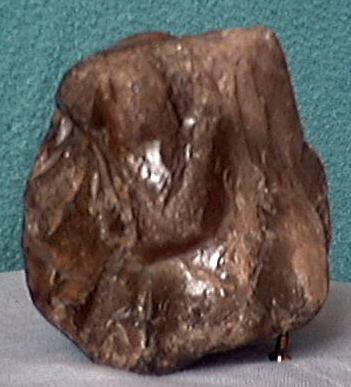
Width of the face cm. 8.5. Height of the face in oblique cm.7,5. The removals of the silex concern the whole surface of the representation.
TYPOLOGY OF TECHNOLOGY
The sculpture of Maribo is completely worked from every part, that is there are no parts of the stone with previous shapes that have been employed.
The technique of removal of the flakes in order to model the represented form was performed with a soft striker (wood or bone), but I am not able to establish if this technique is of Acheulean or Clactonian tradition, however, the two cultural traditions are often found associated in the Italian Paleolithic deposits.
I publish this sculpture of the Denmark together with a bifacial tool on pebble of the evolued Acheulean found in Italy in order to make to see the affinity of working regarding the removal of the flakes.
This Danish sculpture has removals in every direction, in how much the pebble was rotated under the blows of strikers of several type, in order to remove the material in order to give it the wanted shape.
The Italian tool (Fig. 7) is obtained from a pebble, and the technique of removal of the flakes is much simpler, in how much is only directed to point the pebble, and to make it sharp.
The not chipped part of the tool is the original peel of the pebble of silex; instead the dots that are seen on the sculpture of Maribo, also this in silex, are the blows from alluvial tumbling on the chipped parts of sculpture itself.
The technique of removal of the flakes in the sculpture and the tool are of the same type and level of quality, that corresponds to the same cultural phase.
Also two different cultural phases, but contemporary, can have the same level of technological quality.
At the end of the lower Paleolithic, in several parts of Italy, we find the Acheulean, that often is associated to the Clactonian. These two cultural phases, which have been studied only through tools, are found separated or combined, namely : Acheulean, Clactonian or Acheulean-Clactonian. The cultural differences between these types of tools often are conditioned from the lithical material existing in the zone, that is from the size of the pebbles of silex or from fragments of rock, with absence or scarcity of pebbles; however, they are small differences, that make laborious the interpretation.
The processing technique quality in Maribo sculpture consists of a range of flake removals including roughing, shaping and finishing, i.e. large flakes, medium flakes and small flakes being removed.
The technology for the manufacture of the Paleolithic stone sculptures in general, and of this one of Maribo in particular, is more advanced than the technology for the manufacture of tools. In fact, a great difference exists, both in the technique of working, and in the final result.
Material removals in the pebble or rock fragment to fabricate tools cause reduction of the external surface to obtain sharp, cutting, or scraping tools.
Material removals in the pebble or rock fragment to fabricate sculpture cause the reduction of both the external and internal surfaces.
I can only hypothesize, for the fabrication of sculptures in silex, the use of chisels of wood or bone, of varying dimensions, probably not pointed, that were held with a hand, and beaten by the striker with the other hand in order to make hollows and curves under the external surface of the stone.
I want to add that the use of the microscope for the working control has been useful for the engraving on the bones of animals of Paleolithic art works, and on very small sculptures and engravings on soft stone, but for the sculpture of Maribo, made in hard silex, apply the same norms of evaluation in use for the interpretation of the technique of working of the Acheulean tools in silex.
INTENTIONAL PORTRAIT
In Art History, portraits of man have been classified into two types: the intentional portrait and the physiognomic portrait.
The physiognomic portrait is a delineation of individual personality, i.e. what we get today with photograph, and can be found in Hellenistic Greece, for a short time among the Romans, and then in Europe during the Renaissance, with the preceding medieval portraiture, which was restricted to statues of the deceased placed on graves.
Intentional portraiture, instead, is present at every evolved civilization in the world and in every time.
In ancient Egypt the intentional portrait reached very high levels of imitation both in sculpture and in painting: in fact we can distinguish the blond Libyans of Cyrenaica with blue eyes, the Asians, the Egyptians, the Negroes of different ethnic groups, the Ethiopians, and others, both for the physical features and skin color, both for the hair styles and manner of dress.
Same discourse is valid also for the archaic Greece, where in the many celebrating portraits dedicated to the heroes, the model was absolutely conventional.
The two heads of bicephalic anthropomorphic sculpture of Maribo, like all the anthropomorphic sculpture of lower and middle Paleolithic, should be considered "intentional portraits" rightfully.
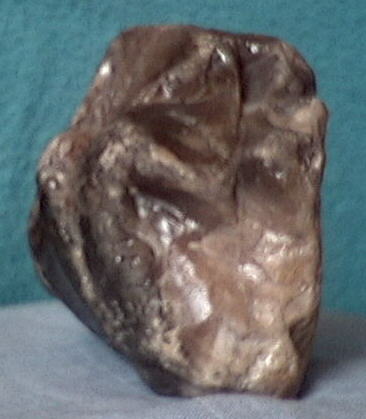
Frontal representation of half human head, which should be observed in semi-frontal perspective. Anatomically it is a little enlarged compared to the proportions of a normal head. See also the drawing (Fig. 2 side B).The profile of the head is depicted on the left, while it is not depicted on the right. The typology (side B), generally is found in sculptures of single heads, that are in semifrontal relief, and flat on the back.
This head has therefore two setups of depiction that are more important, namely the profile of the face, both frontally and laterally.
To the contrary of the other coupled head (side A), in this one, the face has less importance in the representation, since only a generic orbital zone and a zone corresponding to the mouth are depicted. The maximum width of the face is 6 cm. The height of the face in oblique is cm.10. Every part is well worked through the removal of the material, while the left lateral profile is carved with greater care, in how much, evidently, considered more important to the aims of the representation.
COMPOSITION AND SHAPE
The anthropomorphic lithic sculpture of the lower and middle Paleolithic has several types of rare representation: the only head, the head with bust, the bicephalic head, where the setup of the " intentional portrait" is always in semifrontal perspective.
In the figures with body, of which the more known are the feminine ones (Venuses), in many cases the sculpture is all round, but the feet, the face and generally arms and hands are missing. However, some absences and some presences are due to technical facts, varying from zone to zone within the same cultural phase. . In some zones where the stone is hard, the Venuses have been carved without arms and hands, in others where the stone is soft, arms and hands have been carved or engraved too.
Composition and shape increase quality with the technical progress, that is with the inventions with which man will have the possibility to produce art with greater details; but this I believe not to be all, in how much new techniques allow the man new creative researches, with a general increase of quality.
Maribo sculpture enters totally in this argument, and this can be understood looking at the sculptures of the cultural phases preceding the evolued Acheulean.
TYPOLOGY OF STYLE
The two heads of Maribo sculpture have two different styles, that correspond evidently to two different traditions. One is more realistic (Fig.4 side A) with beard and nose, the other is more idealized (Fig.5 side B). I think that the majority of readers will have difficulty in perceiving these differences, however it is necessary to make an effort, because in these researches are so few the elements to analyze that everything must be taken into account. However, every component of today's art, provided it is not superfluous decoration, has its roots in the Lower Paleolithic, so if a component is missing it can certainly be found, even if it apparently does not seem to exist.
In the interpretation of the Paleolithic art it is necessary to hold in account the style, as it is held in account for the art of every time, without discriminations.
For example, the painting of the Upper Paleolithic in Europe, Africa and Australia has in common composition and form (although there are differences), while the style is completely different from continent to continent. And in Europe, whose art I know well, the style is different from area to area, and is different in time even in the same area.
The style is the language of the art, since is the way of the time to make art. This is verifiable: among prehistory, protohistory, historical ages and ethnography there are hundreds of human heads (carved or painted) produced by hundreds of different populations, in which the style is always different: very realistic, deformed for lengthening, with abolition or attenuation of particulars of the face, etc.
For artistic style of a people is always meant the dominant style, because next to a dominant style can survive in traditional and minoritarian form other styles, destined to extinction, or to integrate to the dominant style by introducing transformations.
In the style of the art there is no "quality" , and neither can comparisons be made between one civilization and another. Today's observer may or may not like an ancient style, but the quality of the style should not be discussed. Since style is the language of art, it would be like bringing the spoken language into question, that is, claiming that English is better than German, or Japanese is better than French.
It is necessary to ponder about the two styles of Maribo 's sculpture.
It is necessary to ponder about the two styles of Maribo's sculpture.
ARTISTIC ACTIVITY
The sculpture of the evolued Acheulean follows a tradition deriving from the previous phases and continuing in the successive phases, and the same thing can be said also about the tools; but these are two human activities that have two different traditions at the same time.
The production of lithic tools has always been much numerous, in how much, given the usury, the consumption was high, and this is testified from the enormous amount of finds of tools, in comparison to the Paleolithic sculptures that were found.
It is highly probable that the man who made tools, within the same clan, produced at the necessity also sculptures, and this is not in contrast with the consideration of two different activities, as they will fully develop in two different activities in post - Paleolithic ages.
Stone working to make tools is a specialization, and sculpture making is a greater specialization..
However, in the Acheulean it is general opinion that there was a subdivision of the tasks, in which the more idoneous men went hunting, others slaughtered, some made the tools, and probably the sculptures, etc.
The figure of the artist is important; so I want to imagine that when the artist produced a sculpture, he was held in high estimation, at least for what the sculpture represented in the spiritual sphere.
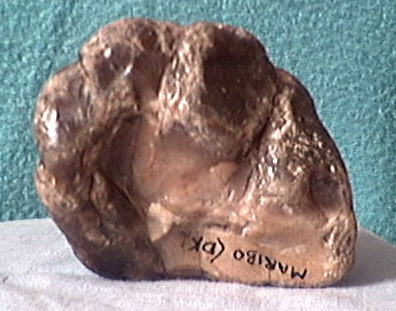
This sculpture, as all Paleolithic sculptures, has not a base as, instead, generally have the sculptures of historical age.
The left part is the underneath of the head of the presapiens (Fig. 4 side A). As we can see, the representation of the mandible is complete, and is hollowed under in order to make more evident all the shape. This jaw is carved with great care, and the chin and beard are also depicted. The use of hollowing under the mandibles in order to evidence the form, probably is connected to the use of conservation of the skull of the dead relative, that just is vacuous.
The part to the right of this photograph is the under of the head of the preneanderthalian (Fig. 5 side B), where the part at the bottom, which is flat, corresponds to the unsculpted part of the half head of preneanderthalian (Fig. 5) right side, instead the curve at the top, always from the right side, corresponds to the under part of this head, that is to the shape of the jaw of the preneanderthalian himself (Fig.5).
HAIRDRESSING AND BEARD
In the anthropomorphic lithic sculpture of the Paleolithic the styles of hairdressing are much reduced.
In the sculptures of single heads we find various types of hairdressings , between which a type, enough frequent, of pointed heads, that can be interpreted like a cap or like a cone hair hairstyle, also still present in the African ethnography, and in the artistic representations (sculpture, ceramics, painting) in the historical times, in all the continents, except Australia.
In the Paleolithic sculpture are represented men with and without beard, and it is not plausible that those without beard, that are in greater number, were all women or young beardless men. Who had a degree of civilization so high to produce sculptures and tools of quality, was sure able to cut the beard.
Also these few elements of the style must be held in consideration for the study of the physical and cultural anthropology.
The bicephalic anthropomorphic sculpture of Maribo represents a head of bearded man, that seems to me a presapiens type, and is a male (Fig.4 side A), while the other not bearded head could be a woman, but it is not sure, and seems to me a preneanderthalian type (Fig.5 side B).
RELIGION
I have always thought that all the Paleolithic art was connected to the religion, in a very generalized way, and without looking for possible interpretations, in how much I considered connected to the religion also the cult of defuncts.
In the archaic Greece the cult of the defuncts was disconnected from the religion; and this could have happened also in some period of the Paleolithic, or perhaps in all the Paleolithic.
However the sculpture of Maribo, that is or less connected to the cult of the deceased, just like in the ancient Acheuleans case, which preserved the skull of the deceased relative, whether this was or was not a cult connected to the religion, demonstrates that in both the cases spiritual rituals always existed, and of group.
BICEPHALY
I consider the bicephalic anthropomorphic sculptures of the Paleolithic age as connectable to the religion, since, in the historical periods and in the ethnography, the bicephalic anthropomorphic representations always represent deities.
The bicephaly is one of the most developed themes in the study of the ancient historical religions. However, in the span of hundreds of thousands years, like in the evolued Acheulean, it is possible that the bicephalic anthropomorphic sculptures were unconnected with the religion in some periods, and connected to other cults, like that one of the dead people, or to the celebration of a marriage, or something else .
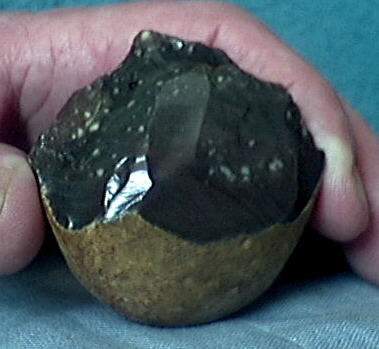
Gained from a pebble of silex. Chipped from the two sides. Measures: width cm. 5.5, Height cm. 5.2. Weight Kg. 0.100. It is made from a pebble of flint. It is chipped on both sides. Measures: width cm. 5,5, height cm. 5,2. Weight Kg. 0,100. It has the same technique of the flakes asportation as the sculpture of Maribo. Many removals are really identical; but in the sculpture of Maribo the technique is more refined, with removals in every direction, and with real carvings by percussion and to model the shape, what does not exist in the tools, and not even in this biface.
CULTS
In the lower Paleolithic, whose length is of several million years, were not found burials of the whole corpse, but only of the skulls; with the exception of the evolued Acheulean, in which have not been found not even the skulls.
Many scholars have connected these skulls to the cult of the defunct, and I share this opinion: even if there has been a gap of finds in the evolued Acheulean of 300,000 years, this cult has continued in the middle Paleolithic near some peoples neanderthalians, because other neanderthalians, in different zones, buried the deceased in position of sleep.
The use of conservation of the skull of the deceased relative is continued in the ethnography of Homo sapiens sapiens.
In the lower and middle Paleolithic a relation exists between the cult of the skulls and the anthropomorphic sculpture of only heads, which indicates that the dimension of every spiritual interest of the man was connected to the only head.
RITUALS
The rituals in the lower Paleolithic were certainly of several types during the course of the year. About the rituals regarding the production of anthropomorphic lithic sculptures we do not know nothing, but we have some clues.
The anthropomorphic lithic sculptures of the lower Paleolithic have never been found in places of dwelling, and not even in places with high concentration of lithic tools, that generally were close to the places of dwelling, like it happened in the middle and upper Paleolithic.
The anthropomorphic lithic sculptures have been found in isolated places, that are assumed to be places of cult. Therefore, supposing that the places of finding were places of cult, it follows that in those places rituals were performed with the sculptures.
However, the places of cult (or presumed such)in the Lower Paleolithic are much rare, as they are the places of dwelling, as generally the sculptures are found in alluvial deposits, transported in bulk from the waters together with tools and debris of every type.
MYTHS
The myth is the narration of the facts of the divine, heroic, human world, not excluded the fabulous of the animals.
The myth is not proper of a single individual, but of all a people, that in it finds expressed its spontaneous vision of the world, the origins of its religious tradition and its history, and the beginnings of its scientific thought.
The artist who produced the sculpture of Maribo, if he didn' t have his own myths and traditions, would have not been able to produce a work of such high quality.
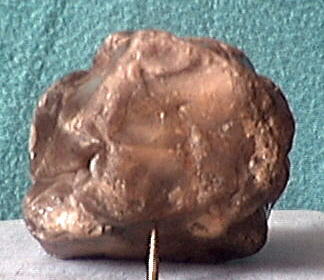
MAGIC OF HUNTING
It is a recurrent theme in the interpretation of the Paleolithic art, but it is not applicable to the anthropomorphic sculpture of Maribo.
MAGIC OF FECUNDITY
It is a recurrent topic in the interpretation of the Paleolithic art, but is not applicable to the bicephalic anthropomorphic sculpture. Generally, fertility magic has been applied to zoomorphic paintings and female figurines (Venuses) of the Middle and Upper Paleolithic.
SYMBOL
In the primitive religions the symbolism is identified with the practice of the magic, has realistic value and is practically identified with the thing which it wants signify: totemic rituals, magic dances, mimic expressions, animal disguises are all occult and magic manifestations that want to mean identification between what one wants to represent and the representation itself.
We can hypothesize that the bicephalic anthropomorphic sculpture of Maribo (like other sculptures of the evolued Acheulean) has had symbolic use in the rituals.
The use, however, is not a component of the Paleolithic sculpture.
In the sculpture the main component are the carved human heads, that can represent men of different types, and this can be seen. What is not visible, but that is assumed on the base of historical and ethnographic parallelisms, is if these heads represent deities, or dead people, or something else still. However, nothing is known about the use that man made of these sculptures.
We know instead that the man manufactured some types of lithic tools, that were useful to him in order to quarter killed animals, to scrape skins and to cut them, etc. For the tools, therefore, we know the use, while for the sculptures we do not know it.
In consideration that, whatever man produces, it must have a use, we hypothesize a symbolic use in the rituals.
By hypothesizing the symbolic use in the rituals the problem is not resolved, moreover, not knowing what these sculptures represent, we cannot even imagine the type of ritual. However, the hypothesis of the symbolic ritual excludes that one of the art for the art.
PALEOLITHIC SHAMANISM
In the ethnography the shaman has the functions of a our priest, but in some cases, in other aspects, he has also more, as there are shamans who are also doctors, interpret dreams, converse with the forces of nature, etc.
In the evolued Acheulean, given the high degree of quality in the production of sculptures and tools, and in which it is surely a subdivision of the working in the group, it is hypothesized the presence of the Paleolithic shaman.
The maker of lithic tools, made also the sculptures? It is much probable that it was the same person.
Among the primitive populations the shaman has a disciple to which he teaches all his knowledge.
In sculpture as in lithic tools we assist, from the first phases of the lower Paleolithic to the end of the upper Paleolithic, to a continuous evolution in the improvement, even if often in a same zone we find some gaps or some changes of quality, due to migrations or perhaps to invasions.
This uninterrupted continuity to the improvement of the artefacts was transmitted from persons responsible that probably were shamans.
Therefore it is not to exclude, into numerically small communities, that who produced tools and sculptures was just the shaman.
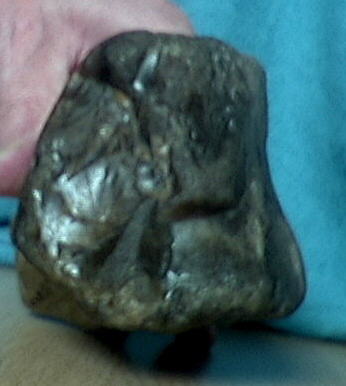
AESTETHICS
In art of every time and place in historical times there are works done well and others done badly. The ones made well can be beautiful, or horrendous, when is matter of representations of the death, of monsters, etc.
In prehistoric, protohistoric and primitive art the same rules of the historical times apply, both in sculpture and in painting, but in the evaluation it must be considered that, if the quality level is inferior to that one of the historical times, this is due to technical less perfected tools, in how much not still invented.
The bicephalic anthropomorphic sculpture of Maribo is splendid, in comparison to others of the Acheulean, and the man, that is the artist, could not do better with the tools he had. To fully appreciate it, it would be necessary to turn it between hands; however, the photographs are exhaustive. Undoubtedly, who is not trained in these studies will have surely difficulties to find a minimum of beauty in it, however it is necessary to deeply investigate also this aspect, which will be developed by man in art of the following periods.
SCIENCE OF ACHEULEANS
Science also means theory and inventions that technology can accomplish.
In Hellenistic Greece all the machines invented by the scientists of the time were feasible
Leonardo da Vinci (Anchiano 1452 - Amboise 1519) with his extraordinary talent as draftsman and observer was able to put into practice some of the ideas contained in the ancient Hellenistic texts: from the study of hydraulic works to anatomy with the dissection of corpses. However, Leonardo's drawings generally depict objects that were not feasible in his time because the corresponding technology was lacking, since Hellenistic technology had been lost.
Just as we investigate the origin of art, also is worth thinking about that of science, which has been integral part in the progress of art.
n every Paleolithic age, the presence of new technologies, not known in the previous age, must be considered as result of a scientific thought, that is a form of prescience. In spite of every our engagement, in a lithic artefact of 300,000 years ago it is not possible to separate the scientific contribution of the new invention from the technology of the time, as the scientific contribution is applied directly to the technology, that automatically improves, and this is true both for the sculpture and for the tools.
However, the inventions are verified In several ways: through the technological progress of a cultural phase in comparison to that previous one; through the differences of technology between sculptures and tools of a same cultural phase; the differences between the various types of sculptures of a same cultural phase; the differences between the various types of tools of a same cultural phase. The verification is easier among the tools, that are much more numerous of the sculptures, in how much some types are repeated always equal for long periods, without improvements, because they are equally useful to the wished purpose, while others are perfected, following new inventions. Progress in tools occurs to improve production related to material life and economy, while progress in sculpture and art in general occurs to improve spiritual life, which also includes communication through images.
Copyright©2000-2002 by Paleolithic Art Magazine, all rights reserved.